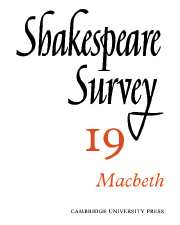Book contents
- Frontmatter
- ‘Macbeth’ in the Twentieth Century
- The Criminal as Tragic Hero: Dramatic Methods
- Antithesis in ‘Macbeth’
- Why was Duncan’s Blood Golden?
- Image and Symbol in ‘Macbeth’
- ‘Macbeth’ and The Furies
- Hell-Castle and its Door-Keeper
- ‘His Fiend-Like Queen’
- The Fiend-Like Queen: A Note on ‘Macbeth’ and Seneca’s ‘Medea
- Shakespeare at Street Level
- New Findings with Regard to the 1624 Protection List
- Shakespeare Productions in the United Kingdom: 1965
- The Royal Shakespeare Company 1965
- The Year's Contributions to Shakespearian Study: 1 Critical Studies
- 2 Shakespeare’s Life, Times and Stage
- 3 Textual Studies
- Index
- Plate Section
2 - Shakespeare’s Life, Times and Stage
Published online by Cambridge University Press: 28 March 2007
- Frontmatter
- ‘Macbeth’ in the Twentieth Century
- The Criminal as Tragic Hero: Dramatic Methods
- Antithesis in ‘Macbeth’
- Why was Duncan’s Blood Golden?
- Image and Symbol in ‘Macbeth’
- ‘Macbeth’ and The Furies
- Hell-Castle and its Door-Keeper
- ‘His Fiend-Like Queen’
- The Fiend-Like Queen: A Note on ‘Macbeth’ and Seneca’s ‘Medea
- Shakespeare at Street Level
- New Findings with Regard to the 1624 Protection List
- Shakespeare Productions in the United Kingdom: 1965
- The Royal Shakespeare Company 1965
- The Year's Contributions to Shakespearian Study: 1 Critical Studies
- 2 Shakespeare’s Life, Times and Stage
- 3 Textual Studies
- Index
- Plate Section
Summary
Leslie Hotson’s Mr. W.H. is an ambitious attempt to solve most of the problems of Shakespeare’s biography. The conclusions are drawn from ‘Shakespeare’s allusive and symbolical method in his personal or lyrical poetry’. The evidence that Shakespeare used such a method derives from the results that Dr Hotson achieves by assuming that he did. And these results are, as the author is happy to admit, astonishing. The use of regal imagery for the youth of the sonnets implies that he was, factually or fictionally, of regal status. He was, Dr Hotson believes, the Prince of Purpoole, leader of the Gray’s Inn revels. This office was held in 1588 by a Mr W.H.—William Hatcliffe. Dr Hotson finds his very name buried in many of the sonnets. More often than not, one part of the formation derives from those not uncommon words ‘what’ and ‘that’; the occurrence of one of them within a line or two of ‘live’, ‘leave’, ‘left’, etc. is held to be significant. (Apparently Shakespeare’s ingenuity did not extend to indicating the ‘-cliffe’ form of the name.) There are also remarkable ramifications involving true-love knots, coats of arms, one of Hilliard’s best-known miniatures (a portrait, we are told, of Hatcliffe), and Pompey the Great.
- Type
- Chapter
- Information
- Shakespeare Survey , pp. 143 - 154Publisher: Cambridge University PressPrint publication year: 1967



